Wish to boost your brand awareness? Then try out TV advertising.
Why?
- Captivates a larger audience.
- Reach your viewers in a more relaxed, engaged state.
- Makes them more likely to remember the ad and the brand. (especially if it’s a linear ad!)
As per an annual review, ThinkBox thinks that—
“TV advertising can generate over 70% of all profits coming from any marketing or promotional efforts.”
So, no matter how digitally we upgrade ourselves, TV still works to build audience engagement effectively. Its combination of pictures, music, visuals, and messages plays the trick!
However, just creating an ad won’t suffice. You must consider challenges like fragmented viewership and data inaccuracy to understand issues and fine-tune them accordingly. Besides, you also have to use metrics, particularly reach and effectiveness, to measure the success of your ad.
If you’re wondering, why these two? Let’s first know their significance.
All About Reach In TV Advertising
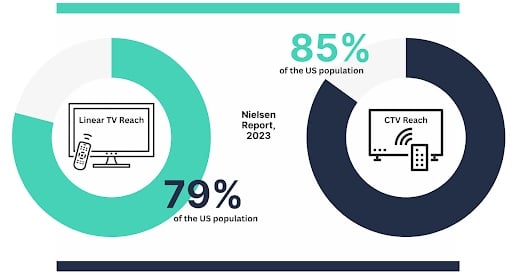
What’s Reach and its Significance?
Reach tells you the total percentage of viewers exposed to a particular content, advertisement, or message through a medium. If it’s just TV advertising, reach refers to how many individual viewers have seen your ads play on their streaming TV devices.
This is considered one of the crucial metrics. Why?
It’s because reach measures your ‘actual’ audience. Through TV ads, you can easily reach a bigger audience since most people still watch TV. Your audience can be specific or broader.
For reach, the golden rule is simple— the more eyes on your ad, the better.
It’s the first step toward making an impact and measuring success in TV advertising.
Significance of Reach in TV Ads
- Measures the potential impact of your message on the audience.
- Sets strategic goals and budgets effectively.
- Increases brand awareness and product recognition.
- Drive higher sales and market presence.
- Boosts engagement and following consumer actions.
4 Metrics To Measure Reach
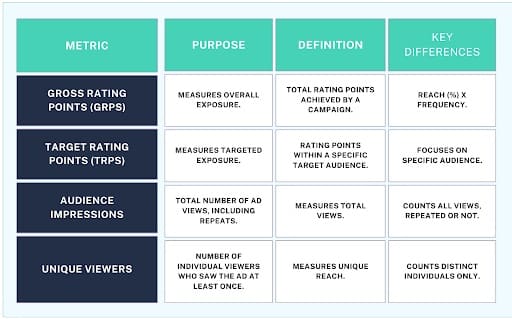
Gross Rating Points
They help you understand the overall weight of your ad campaign on viewers.
Gross Rating Points measure the total exposure of your ad to the general audience and track its influence on them. They are calculated by–
GRP = Reach x Frequency.
Here,
- Reach means the percentage of the audience.
- Frequency means the number of times they see your ad.
Let’s say– your KFC ad reaches 30% of the target audience and is viewed 4 times. Then, it’ll generate 120 GRPs.
Target Rating Points
Similar to GRPs but focus on the specific audience reached by your ad campaign.
Target Rating Points quantify the gross rating points your ad achieves among targeted viewers within a larger population. To calculate this one, you should first determine the GRP.
In that case, the formula stands as—
TRP= total impressions ÷ total target audience x 100
For instance, 1,000,000 impressions among the target audience / 10,000,000 people in total in the target audience x 100 = 10 TRPs
Audience Impressions
Quantifies the number of views your ad achieved.
Audience Impressions show how many times your ad campaign has been viewed by the audience on TV.
The formula is—
Audience Impressions = number of times the audience watched x number of people.
Let’s say, 10 people have seen your Samsung Mobile ad 100 times on TV. So, the Audience Impressions for the ad will be 100 x 10= 1000
Unique Viewers
These give you a clear picture of your ad’s reach.
Unique Viewers count the distinct individuals who’ve seen your ad regardless of the frequency. The metric rather counts a viewer as an individual than counting up their views.
For instance, A unique viewer may check out your Coca-Cola ad on TV but then might watch it again through their phone. Although this would count as two views, the unique viewer is one.
Tools and Techniques for Measuring Reach
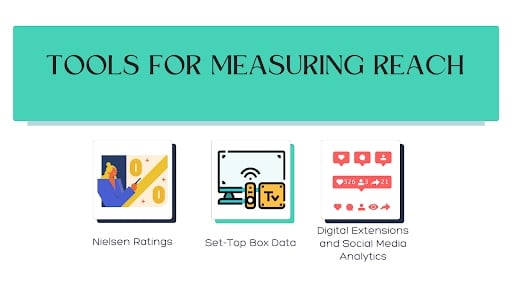
Nielsen Ratings
They are 100% about the viewing advertising.
Expressed as a percentage, Nielsen Ratings measures the total number of viewers for your TV ad. They help you understand how many people have watched your ad and who they are.
Set-Top Box Data
Comes straight from cable, satellite TV providers, digital signals, or internet data.
Set-Top Box Data measures precise viewing patterns and ad exposure using set-top boxes. This can be channel changes and view times but the data is collected from the device.
Digital Extensions and Social Media Analytics
Focus on extended reach and interaction.
Digital Extensions and Social Media Analytics measure the additional reach and engagement with TV ads on different platforms. It includes metrics such as— views, shares, likes, reactions, and comments.
All About Effectiveness of TV Advertising

What’s the Effectiveness of TV Advertising and its Significance?
Effectiveness shows how well your content can deliver its message and persuade your viewers to take action.
For TV advertising, effectiveness measures the impact of your ad and the degree to which all your objectives are achieved. It determines whether your brand’s marketing efforts are hitting the mark with your target people and if it’s getting the best returns.
Effectiveness is another crucial metric to measure success. An ad with a higher reach might get viewed by multiple people. However, if it doesn’t lead to any action, it’s not effective.
Through this metric, you can understand your ROI and refine future ad campaigns.
Significance of Effectiveness in TV Ads
- Optimizes your spending to maximize profits.
- Results in higher viewer interest and better recall of the brand.
- Creates a strong brand image so your viewers easily remember you.
- Helps capture a larger market share to establish a stronger market position.
- Create a clear call to action and increase engagement.
3 Key Performance Indicators
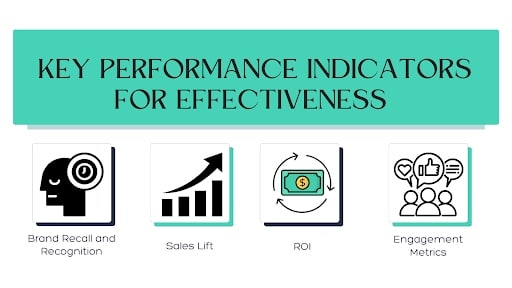
Brand Recall and Recognition
Brand recall and recognition are key components of brand awareness.
Brand Recall and Recognition measure how well your viewers remember your ad and recognize your brand as soon as they see one. However, their roles are different. Brand recall is more effective in attracting existing customers. Meanwhile, brand recognition is effective in creating new ones.
The stronger or more memorable your ad— the higher the brand recall or recognition. This shows your ad’s effectiveness. This further helps trigger someone to buy something from your brand.
As per a Neilsen study, TV ads have an average brand-aided recall rate of 32%.
The formula–
Percentage Brand Recall = The number of respondents who correctly identified your brand ÷ total number of survey respondents x 100
Sales Lift
Sales Lift measures the boost in total sales as your ad airs on TV. It’s the increase in sales you observe during an ad campaign compared to what sales would have been without the campaign.
This gives a benchmark so you understand the effectiveness of your marketing campaign through TV.
Comparing incremental sales to base sales can help you determine the true impact of your ad marketing efforts and optimize your strategies for maximum ROI.
Here,
- Campaign Sales means average sales during the advertising period.
- Baseline Sales means average sales during a period without advertising.
The formula—
Sales Lift = Campaign Sales−Baseline Sales
Return on Investment
ROI works to figure out how much profit and revenue growth you’d get from your ads on TV. It compares the cost of your ad to the revenue it generates.
ROI is considered one of the most important KPIs. It’s because the ratio is based on your specific advertising goals. Plus, it shows the true effect your advertising efforts have on your business.
As per a study by the Ebiquity and Gain Theory—
“TV ads help you achieve an average ROI of $4.20 for every dollar spent.”
- A 4:1 or 5:1 ratio here usually indicates a good ROI.
The formula—
ROI= (Revenue from the ad campaign − Cost of the ad campaign ÷ Cost of the ad campaign) × 100
Engagement Metrics
Indicators that are the holy grain in the world of TV advertising.
Engagement metrics are data points that show how effectively your viewers respond to your content. EMs give you a clearer picture of how your marketing efforts are paying off.
Some common engagement metrics are—
- Click-through rate (CTR)
- Video completion rate (VCR)
- Website visits
- Social media interactions
They show that the viewers are interested in your brand after seeing your ad.
Methods for Measuring Effectiveness
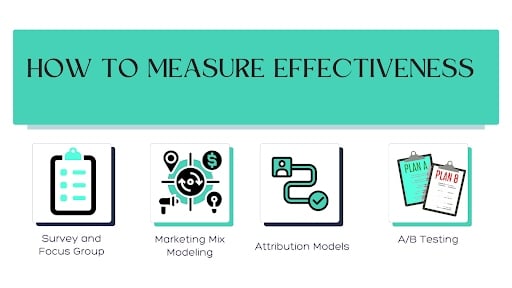
Surveys and Focus Groups
They work like a tool to assess reactions.
Surveys and Focus Groups are methods to gather direct feedback from viewers of your ad on TV through samples. These tools give you insights into their impact and effectiveness.
Not just that! They also help you find the likes and concerns of your ad campaign. This way, you can improve your understanding of the market or customers and fine-tune your marketing styles.
For example, a survey may reveal that 50% of viewers remembered your ad’s key message. This shows the average effectiveness of your TV ad.
Marketing Mix Modeling (MMM)
An old tool but works wonders in digital marketing.
Marketing mix modeling (MMM) is a statistical analysis technique that analyzes different marketing tactics on—
- Sales
- Market share
- Consumer behavior
- ROI
The tool determines how each marketing method contributes to sales and helps you see the specific effectiveness of your TV advertising.
Such models provide information on how various actions like— advertising spending, promotions, and pricing— influence sales or ROI.
Attribution Models
These frameworks focus on your customer’s journey.
Attribution modeling is a strategy that lets you analyze and attribute sales to marketing touchpoints occurring at specific steps of your buyer’s journey. As they engage with your brand, they are exposed to the points— both paid and organic. This can influence them to take action.
For instance—
- Searching for a product online
- Marking a purchase
- Installing something
Such models help you draw meaningful conclusions about how, why, and when your buyer responds to your brand’s ad on TV. This way, you can enhance the effectiveness of your ad.
A/B Testing
It’s mainly a split testing.
A/B Testing for TV advertising refers to an experiment in which, you split your audience to test variations on an advertising campaign and check which performs better. There will be two versions of the marketing content—A and B.
So, you show one-half of your audience version A of a piece of content and B to the other.
With this, you see which one is more effective. This helps you make data-driven decisions and create better TV ads.
Combining Reach and Effectiveness

Both reach and effectiveness are like two hands of the success of TV advertising.
So, to get a holistic view, why not combine both metrics?
Importance of Integrating Both Approaches
Complete Audience Insight
You get a full picture once you combine reach and effectiveness.
For example, 70% of your target audience saw your ad and 50% bought your product. This shows true impact.
Optimized Spending
Efficient merging helps you allocate your budget smartly. Let’s say–
Your ad on TV reaches 1 million but only 10,000 react to it just because the timing for the ad isn’t prime. In that case, you can shift the budget to a different, prime time slot. It makes sure you’re spending your money more effectively.
Improved Targeting
Integrating reach and effectiveness can refine your target strategies.
For instance, Your ad reached 500,000 viewers but only 70% of a specific group resonated with it.
This indicates that— you should produce TV ads focusing on that target audience.
Better ROI Understanding
Compiling reach and effectiveness for your TVs can bring you clear ROI. Let’s say—
You invested $100,000 in a TV ad. It reached 2 million people and drove 200,000 sales. The ROI is clear. It’s effective and positive.
Case Studies
Let’s spotlight 3 enticing TV commercials that worked for people.
1. Old Spice Ad: Smell Like a Man, Man
- Reach: It reached millions of views, particularly during prime-time TV slots. As per Nielsen ratings.
- Effectiveness: They used social media interactions and website traffic as engagement metrics. Plus, they conducted focus groups to measure brand recall.
- Result: Their TV ad campaign increased sales by 125% within a few months. Plus, it got over 105 million YouTube views.
2. Nike TV Ad: Dream Crazy Ft. Colin Kaepernick
- Reach: It reached millions through television, especially during high-profile sports events. As per Nielsen ratings.
- Effectiveness: Nike conducted surveys to understand brand recall and recognition. Plus, they tracked sales lift and social media engagement.
- Results: The ad campaign on TV led them to score a 31% sales spike. Besides, it brought them widespread media coverage and social media buzz.
3. Budweiser Ad: “Whassup?”
- Reach: Budweiser used Nielsen ratings and measured their ad’s reach across various prime-time TV slots.
- Effectiveness: They conducted surveys to assess brand recall and recognition. Plus, they monitored social media to track engagement.
- Result: The ad campaign boosted brand recall and increased Budweiser sales by 7.3% in the first year.
Best Practices For Measuring TV Advertising Success
Setting Clear Objectives
Jot down clear and measurable goals.
Know what you exactly want to do in your ad. Do you wish to:
- Increase brand awareness?
- Drive sales?
- Boost website traffic?
- Attract a specific audience?
Setting clear objectives helps you—
- Make sure all your efforts are aimed at specific outcomes.
- Enable precise tracking of how well your TV ad meets its objectives.
- Allocate budget and resources effectively, meaning max ROI.
- Generate actionable data and make improvements
Choosing the Right Metrics
Align metrics with your campaign goals.
For that, you must choose the right metrics. That’s how you can measure what matters the most and brings you success.
- If your goal is to create brand awareness, create a TV ad focusing on reach and brand recall.
- In case you wish to drive sales, prioritize sales lift and ROI.
Continuous Monitoring and Optimization
After you create a TV ad, you shouldn’t just drop it on TV and sit.
Instead, you have to keep on monitoring your metrics. Check the outcome, make adjustments based on that, and then optimize.
Let’s say, your ad isn’t performing that well. Figure out the lacking. Tweak your strategy. Then optimize your ad campaign for effective results.
Through continuous monitoring and optimization, you get—
- Real-time insights
- Quick adjustments
- Maximized ROI
- Identifying trends
- Boosted performance
Challenges and Solutions in Measuring TV Advertising
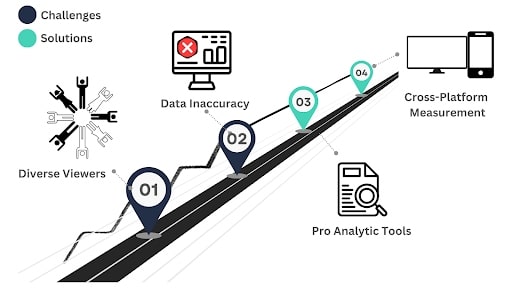
Common challenges
Fragmented Viewership
TV audiences are fragmented into different categories and degrees. Even if the available viewing options set is similar, you’ll find it dispersed.
People now watch TV on multiple platforms—
- Traditional channels.
- Streaming services like Netflix.
- Digital platforms.
A.C. Nielsen Company says, “The average American watches about 5 hours of TV a day.”
However, the time is split between different services.
This makes it hard for advertisers like you to track who’s watching your ads. It even gets confusing how effectively the ad is working across multiple platforms.
Questionable Data Accuracy
Traditional methods like surveys and focus groups use samples of viewers. This might represent some of your consumers but not the whole audience. Result– data inaccuracy.
Nielsen’s research has already shown that sample-based methods can have errors.
This can lead to incorrect conclusions about your ad performance. This means— you may not get the full picture of who saw your ads and how it affected them.
Solutions and Innovations
Advanced Analytic Tools
You’ll find some new analytic tools that use advanced technology to give better insights.
Two of them are—
- Nielsen’s Total Audience Measurement
- Comscore’s TV Essentials
These two combine data from different sources. For instance—TV, digital platforms, and social media. They help you get a more accurate understanding of the reach and effectiveness of your ad.
Cross-Platform Measurement
This one helps you understand how audiences fragment their attention.
Cross-platform measurement tracks ad performance across platforms like TV, digital space, and mobile platforms in just one place.
Roku and YouTube offer this kind of measurement. You can use them to see how your ads are working across different media.
Future Trends In TV Advertising Measurement
Role of AI
Analyzes vast amounts of data. Thus, you get deeper insights into TV ad performance.
Machine Learning
Enhances the accurate prediction of viewer behaviors as you continuously learn from new data.
Shift Towards Digital Integration
Combines digital factors to get you a comprehensive view of your ad’s effectiveness. This can be— TV, online advertising, and multiple metrics.
Exploit Reach And Effectiveness To Enjoy Success
The landscape of TV advertising keeps evolving. To keep up with the change, you must adapt to different methods to measure success.
The best way would be to mix traditional and advanced methods. Stay updated with the tools and techniques and keep refining your strategies. Also, get the super-quality video production. Local Eyes is here to help you with that.
Make sure your TV ad reaches people and creates a positive impact on them.
Frequently Asked Questions
Reach counts the unique viewers who see your ad whereas impressions count the total number of times your ad is viewed. It includes repeat views too.
Use surveys, focus groups, digital analytics tools, and A/B testing. These can help small businesses gather feedback and measure effectiveness.
GRPs count the overall ad exposure to the audience. They are calculated by multiplying the reach by the frequency.
MMM analyzes the impact of different marketing activities on sales. This way, it helps you see the specific effectiveness of your TV advertising.
Yes. Social media analytics can track viewer engagement and sentiment. That’s how it provides insights into how your TV ad resonates with the audience.
The most important KPIs for TV ad campaigns are—brand recall, sales lift, ROI, and engagement metrics.

Founder at LocalEyes Video Production | Inc. 5000 CEO | Emmy Award Winning Producer



